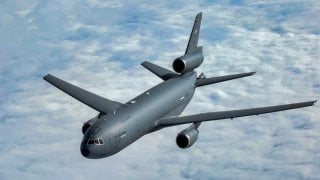The U.S. Air Force Just Retired This Legendary Aircraft
After 44 years of service, the U.S. Air Force has officially retired its last KC-10 Extender, an aerial refueling and cargo aircraft. The KC-10, based on the McDonnell Douglas DC-10, played a vital role in supporting U.S. and coalition aircraft with in-flight refueling during key operations like Desert Storm, Enduring Freedom, and Iraqi Freedom.
What You Need to Know: After 44 years of service, the U.S. Air Force has officially retired its last KC-10 Extender, an aerial refueling and cargo aircraft. The KC-10, based on the McDonnell Douglas DC-10, played a vital role in supporting U.S. and coalition aircraft with in-flight refueling during key operations like Desert Storm, Enduring Freedom, and Iraqi Freedom.
-The aircraft, which could carry over 356,000 pounds of fuel, also supported humanitarian missions and aeromedical evacuations.
-The KC-10's legacy of global mobility ends as it is replaced by the KC-46A Pegasus, with the final aircraft heading to the "Boneyard" at Davis-Monthan AFB.
From Desert Storm to the Boneyard: KC-10 Extender's Historic Retirement
Though it never received quite the fanfare of the B-52 Stratofortress or the B-2 Spirit, the long-range strategic bomber couldn't have accomplished its mission without the aid of the United States Air Force's KC-10 Extender. However, even as the B-52 is seeing its operational life extended and could remain flying into the 2040s or later, the KC-10's service has come to an end.
At a ceremony at Travis Air Force Base (AFB), California, last week "Team Travis" members gathered to "bid farewell" to the final KC-10 Extender.
"After 44 years of service, the KC-10 was decommissioned during the final farewell event hosted by Col. Jay Johnson, 60th Air Mobility Wing commander," the Air Force announced.
"For decades, the KC-10 has taken to the skies to provide in-flight refueling, a vital capability that delivers global reach for America and is the lynchpin to joint power projection," said Air Force Chief of Staff Gen. David W. Allvin in a video address. "From its initial days in Strategic Air Command through today, the KC-10 has linked the continents and guaranteed our promise of American airpower anytime, anywhere."
Meet the KC-10 Extender
Based on the McDonnell Douglas DC-10, the KC-10 Extender served as an Air Mobility Command tanker and cargo aircraft. It was developed in the 1970s to provide greater global mobility for the U.S. military and it first entered service in 1981. It was outfitted with three large fuel tanks under its cargo floor – including one under the forward lower cargo compartment, a second in the center wing area, and a third located under the rear compartment. In addition, the KC-10 was designed with three main DC-10 wing fuel tanks. In total, it could carry more than 356,000 pounds (160,200 kilograms) of fuel – or nearly twice as much as the KC-135 Stratotanker.
While the KC-l0's primary mission was aerial refueling, the aircraft was also designed to provide greater flexibility with each KC-10 able to carry nearly 170,000 pounds of cargo and up to 75 people. The versatile Extender could also be employed to transport "litter and ambulatory patients using patient support pallets during aeromedical evacuations," the aircraft's fact sheet explained.
Throughout its more than four decades in service, the KC-10's primary mission was aerial refueling but it was also able to airlift personnel and equipment during overseas deployments. In addition, it was widely used in humanitarian missions and it has provided rapid response to natural disasters including hurricanes and earthquakes.
The KC-10 played a significant role during 1991's Desert Shield and Desert Storm operations, helping transport thousands of tons of cargo and thousands of military personnel, while it provided in-flight refueling for U.S. and coalition aircraft.
"The KC-10 and the KC-135 conducted about 51,700 separate refueling operations and delivered 125 million gallons of fuel without missing a single scheduled rendezvous," the air service stated.
During the subsequent operations Enduring Freedom and Iraqi Freedom, U.S. Air Force KC-10s took part in 1,390 missions and delivered critical air refueling support to numerous joint and coalition receiver aircraft.
Flying to the Boneyard
Though the KC-10 Extender has been officially retired, the aircraft will make a final flight fittingly to the 309th Aerospace Maintenance and Regeneration Group at Davis-Monthan AFB, Arizona – the U.S. Air Force's famed "Boneyard."
The KC-10 is being replaced with the KC-46A Pegasus. As of this month, 88 of the new Pegasus aircraft have been delivered.
Author Experience and Expertise: Peter Suciu
Peter Suciu is a Michigan-based writer. He has contributed to more than four dozen magazines, newspapers, and websites with over 3,200 published pieces over a twenty-year career in journalism. He regularly writes about military hardware, firearms history, cybersecurity, politics, and international affairs. Peter is also a Contributing Writer for Forbes and Clearance Jobs. You can follow him on Twitter: @PeterSuciu. You can email the author: [email protected].
Image Credit: Creative Commons and/or Shutterstock.


